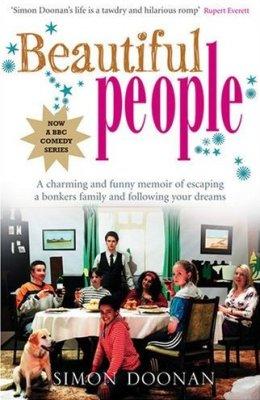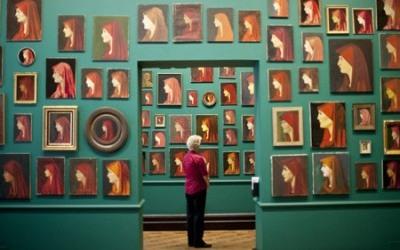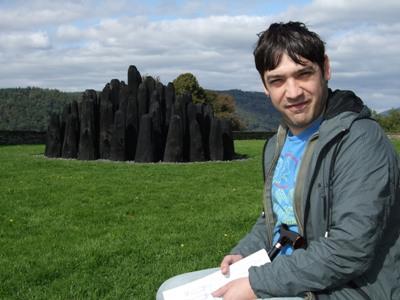More Beautiful People
18 September
A little while back, Phil introduced me to the fabbity BBC TV series Beautiful People.
 As well as loaning me DVDs of the TV show, he also leant me the autobiographical work by Simon Doonan on which the series was based. Originally called Nasty - My Family and Other Glamorous Varmints (thus parodying Gerald Durrell), the book has been renamed Beautiful People as a tie in.
As well as loaning me DVDs of the TV show, he also leant me the autobiographical work by Simon Doonan on which the series was based. Originally called Nasty - My Family and Other Glamorous Varmints (thus parodying Gerald Durrell), the book has been renamed Beautiful People as a tie in.
And, really, there, you have to say, the similarities pretty much end. Growing up gay in Reading in the 1950s was a completely different business from growing up gay in the 1990s. I wouldn't say that it would have necessarily been any the easier but certainly different.
Humour, there is still aplenty but, again, it is a very different sort of humour. Most of the characters are different. Most of the situations are different. I think that, if I'd read the book first and then seen the TV series, I would have had a similar jolt. They are just two different stories with the same title. And I have to say that I enjoyed the TV series much, much, more. So, just two and a half stars here.
![[Two and a Half Stars - Reasonable]](2_5star.jpg)
On Sunday, I went to Crosby beach. Nothing too spectacular there. However, I was due to meet up with people I hadn't seen in a long time. The springboard for this operation was
Denise who I had last met up with in 1999 when I was still in London. Also in attendance was Graham who was part of our crowd. Unfortunately absent was Ronnie who again I haven't seen in over a decade but who is living with the aftermath of his partner receiving very bad health news.
We made a motley bunch - the reason for the gathering was the sixtieth birthday of Chris who entered into the collective story in the the late 70s during the Daisy Bank Road period in Manchester. I visited a few times and met Denise's first daughter, Rowena, then when she was but a few months old - she also was there and is, presumably and mathematically, somewhere around 30 by now.
Anyhow, we talked, we ate, we looked at the Antony Gormley's. I realised that one of my current students, Mike, looks a lot like Graham used to when he was twenty - which would explain the passing fancy. Graham in his fifties is still a fine figure of a man - he's just a slightly paunchy, middled aged man with greying hair. It was fun to move back and forth between the here and now and the remembered then.
In fact, the event had brought up all sorts of memories for me. The most endearing was an evening spent in Ronnie, Denise and Graham's flat in Muswell Hill listening to records of Mahler's Symphony No9 whilst a candle guttered and choreographed a timely demise to coincide with the final few bars. Happy days.
On Monday, I travelled down to London for what is my fifth visit this year. One of the things that I like about keeping this Journal is that it is relatively easy for me to summon up the details of the other four. And here they are...
Quite a bit of culture there. And, although three of those trips were triggered by a specific external focus, I still managed to work something in for me.
This trip was all about me and my desire to hear a concert performance of Donizetti's Linda di Chamounix given at the Royal Opera House. It's been a good year for unusual Donizetti with Lucrezia Borgia at the Buxton Festival and Roberto Devereux at Opera Holland Park. In fact, it's been quite a decade with nine more performances of a further seven different operas. And because I keep this Journal, it is relatively easy for me to summon up their details. And here they are...
This occasion makes ten different operas and twelve performances attended - and still no Lucia di Lammermoor. That sort of achievement would have been impossible even ten years ago and is a marker as to changing tastes among the opera going public.
I'd like to say that this evening was the culmination of that decade of attendance - but no. It's an odd work to modern tastes with comic and serious elements close to hand. We have dark comedies today but they tend to veer towards the savage. This remained staunchly pastoral and good-humoured despite our heroine losing her grip on reality when her purity is called into question.
I've heard Alessandro Corbelli before in Don Pasquale and La fille du régiment and he simply stood out as the artist who understood the genre above all others on the stage. Ludovic Tézier was in better form than when I saw him in L'elisir d'amore but I still don't warm to him. Stephen Costello was new to the house and sounds as though he could grow into being a good lyric tenor - which probably means that he'll be singing Siegfried or Otello in five years' time. Eglise Gutiérrez was Linda and had a interesting voice - warm in its lower registers, fluid in its coloratura but thinning (sometimes) at the top of the range. She's quite early in her career so maybe her voice will settle in time.
Mark Elder conducted and was probably the hero of the hour. I'm glad to have witnessed the piece. It was a good evening but I shan't be racing out to purchase the Opera Rara recording and nor shall I pursue a further acquaintance with the piece.
![[Three Stars - Good]](3star.jpg)
 So, since I was in London, I went round a few galleries. At the National Gallery, I took in Corot to Monet: A Fresh Look at Landscape from the Collection. This was a disappointment. It was really a show to encourage people to buy a new publication. There was no real catalogue and there was no audio tour. It felt thin on content and substance. The Courbet on the right was one of the very few works I got at all interest in. Distinctly average.
So, since I was in London, I went round a few galleries. At the National Gallery, I took in Corot to Monet: A Fresh Look at Landscape from the Collection. This was a disappointment. It was really a show to encourage people to buy a new publication. There was no real catalogue and there was no audio tour. It felt thin on content and substance. The Courbet on the right was one of the very few works I got at all interest in. Distinctly average.
![[Two Stars - Average]](2star.jpg)
 At the National Portrait Gallery, I had a wander round the BP Portrait Award 2009 and then found and fell in love with some Maggi Hambling works - particularly of George Melly and chemist and crystallographer, Dorothy Mary Crowfoot Hodgkin. However, the unexpected highlight was two rooms of works collected by Belgian artist, Francis Alÿs, based around the image of the fourth century Christian saint known as Fabiola.
At the National Portrait Gallery, I had a wander round the BP Portrait Award 2009 and then found and fell in love with some Maggi Hambling works - particularly of George Melly and chemist and crystallographer, Dorothy Mary Crowfoot Hodgkin. However, the unexpected highlight was two rooms of works collected by Belgian artist, Francis Alÿs, based around the image of the fourth century Christian saint known as Fabiola.
 On first entering the two rooms, I thought that I was looking at lots of copies of the same work. And I registered a lot of red. As my eye became accustomed to what it was looking at, I realised that, although they were copies, none of the copies was exactly the same as any other. Some were incredibly poorly executed. Some faced the right rather than the left. Some abandoned the prevailing red for other colours. Some used materials other than oils such as ceramics, beads, enamel, etc.
On first entering the two rooms, I thought that I was looking at lots of copies of the same work. And I registered a lot of red. As my eye became accustomed to what it was looking at, I realised that, although they were copies, none of the copies was exactly the same as any other. Some were incredibly poorly executed. Some faced the right rather than the left. Some abandoned the prevailing red for other colours. Some used materials other than oils such as ceramics, beads, enamel, etc.
 The back story is that Francis Alÿs realised that he was seeing variations on the same image in flea markets and antique shops around the world. So, he began to purchase them and, over a period of fifteen years, collected some 300 representations of the saint. Apparently, they are all based on a late nineteenth century work by Frenchman, Jean-Jacques Henner. This work is now lost. I was totally bowled over by the concept and the execution.
The back story is that Francis Alÿs realised that he was seeing variations on the same image in flea markets and antique shops around the world. So, he began to purchase them and, over a period of fifteen years, collected some 300 representations of the saint. Apparently, they are all based on a late nineteenth century work by Frenchman, Jean-Jacques Henner. This work is now lost. I was totally bowled over by the concept and the execution.
![[Four Stars - Excellent]](4star.jpg)
After that excitement, the Courtauld Gallery's exhibition Beyond Bloomsbury: Designs of the Omega Workshops 1913-19 was much more low key. I really liked the fabric designs. It's amazing how the style, the colour schemes, the tonal palette, the patterning, all still crop up in summer wear even these days but I suppose that it was more immediately to lead to the dazzle ships of the Atlantic convoys.

When it came to the other craft objects, however, I'm afraid that my overall lack of enthusiasm for the fine arts told. I did, however, feel a lot of sympathy for Roger Fry's notion that it was particularly important to emphasise the normality of producing fabrics, pots, glassware and ceramics during the period 1914-18. Unsurprisingly, Fry was a Quaker. Nevertheless, from personal taste, I can't say that I felt the exhibition was more than reasonable.
![[Two and a Half Stars - Reasonable]](2_5star.jpg)
I also took a brief look around the Impressionist collection which so dazzled me in May 2002. It's still very good.
Back home, the following day, Ross and I took another trip up to the Lake District. Over the past few years, I've been up to that area of the country more often than I have been at any other time of my life. And because I keep this Journal, it is relatively easy for me to summon up their details. And here they are...
- a Quaker Attenders' Gathering at Swarthmoor Hall in Ulverston in May 2004
- a performance by English Touring Opera of Giuseppe Verdi's Falstaff at the Coronation Hall in Ulverston in December 2005
- an exhibition of prints by Howard Hodgkin at the Abbot Hall Art Gallery in Kendal in June 2007
- a performance of Daphne du Maurier's Rebecca at the Theatre by the Lake in Keswick in September 2007
- a Quaker training course at Swarthmoor Hall in September 2007
- a holiday at Glenthorne guesthouse in Grasmere which also took in Blackwell in Bowness-on-Windermere in April 2008
- a Quaker Gathering at Glenthorne guesthouse in February 2009
 Our trip this time was specifically to see and exhibition of sculptures by David Nash. We began at Blackwell Arts and Crafts House which we thought so highly of back in April 2008. SInce then, of course, we've both seen similar design styles in the Gustav Klimt exhibition at Tate Liverpool and the House for an Art Lover built to a design by Charles Rennie Mackintosh in Bellahouston Park, Glasgow. I still find Blackwell to be a marvellous place. We had an excellent meal, toured the house and saw Black Dome in the grounds.
Our trip this time was specifically to see and exhibition of sculptures by David Nash. We began at Blackwell Arts and Crafts House which we thought so highly of back in April 2008. SInce then, of course, we've both seen similar design styles in the Gustav Klimt exhibition at Tate Liverpool and the House for an Art Lover built to a design by Charles Rennie Mackintosh in Bellahouston Park, Glasgow. I still find Blackwell to be a marvellous place. We had an excellent meal, toured the house and saw Black Dome in the grounds.


 Then it was off to Kendal and the Abbot Hall Art Gallery in Kendal for the remainder of the exhibition. What was immediately apparent were the links to works by other artists who we both like - James Turrell, Antony Gormley, Andy Goldsworthy and Richard Long. Yes, it's those Land Art people again. I really liked his work. There's going to be a major retrospective of his work at the Yorkshire Sculpture Park next year. We shall certainly look forward to attending that as this show was very good indeed.
Then it was off to Kendal and the Abbot Hall Art Gallery in Kendal for the remainder of the exhibition. What was immediately apparent were the links to works by other artists who we both like - James Turrell, Antony Gormley, Andy Goldsworthy and Richard Long. Yes, it's those Land Art people again. I really liked his work. There's going to be a major retrospective of his work at the Yorkshire Sculpture Park next year. We shall certainly look forward to attending that as this show was very good indeed.
![[Three and a Half Stars - Very Good]](3_5star.jpg)
One drawing was of a circle of ash trees trained (fletched is I believe the correct technical term) to grow into a dome shape. Both Ross and I recognised the work immediately but neither of us could place it. The work itself grows in the Vale of Ffestiniog. As I've been racking my memory banks, I think that I've come up with a strong memory of seeing the drawing as part of a small touring exhibition at Theatre Clwyd when Ross and I went to see Troilus and Cressida back in 2005. We didn't mention it at the time but it's the only venue that seems likely within the time frame available.
 Thursday evening brought a second trip to the Phil for another RLPO concert under the baton of Mr Petrenko. We had a jaunty performance of Haydn's Symphony No 100 The Military - as Nigel said after the performance, it's not often that you see a Jingling Johnny wielded in anger. He was referring to one of the percussion items that reinforced the military band aspect of the work. The first concert that I heard Vassily conduct included Haydn's Symphony No 101 The Clock. I think that he's very good in this sort of work and he's becoming better as he relaxes a little and allows a little more grace to enter this performances.
Thursday evening brought a second trip to the Phil for another RLPO concert under the baton of Mr Petrenko. We had a jaunty performance of Haydn's Symphony No 100 The Military - as Nigel said after the performance, it's not often that you see a Jingling Johnny wielded in anger. He was referring to one of the percussion items that reinforced the military band aspect of the work. The first concert that I heard Vassily conduct included Haydn's Symphony No 101 The Clock. I think that he's very good in this sort of work and he's becoming better as he relaxes a little and allows a little more grace to enter this performances.
We also got a very dapper performance for Hadyn's trumpet concerto with Alison Balsom in excellent form in the soloists part.
After the interval, we had a traversal of Beethoven's Prometheus Overture followed by the Symphony No5. I knew from last year's performance of Beethoven's Symphony No3 Eroica that the sound world would be informed by current thinking on early nineteenth century performance practice. So, for example, the opening statement was taken as one flowing phrase rather than two phrases separated by a pause. Beethoven didn't actually write a rhythmic pulse which was the equivalent of the Morse Code for the letter V. This was a practice adopted during the Second World War when the V was supposed to stand for Victory.
What followed was a gripping and elegant statement of a much known and moved work. However, it came across in shining new colours. The individual parts of the orchestra were allowed to demonstrate the tang and bite of their own flavours rather than forcing everything to blend into a burnished and integrated sonority à la Karajan. I liked it and thought it was very good.
![[Three and a Half Stars - Very Good]](3_5star.jpg)
Thursday and Friday, Ross and I finished off work on the wall. The re-pointing is now complete and I made a sterling effort to cap the wall at the top.




I am incredibly proud of all of this work. I am not a natural artisan. A lot of what I do in this sort of field is far too delicate. But I am the way that I am. And, despite a complete lack of natural inclination for this sort of work, I've done it.
What amazes me still further is that I have been drawing on memories of work that my father, Albert, and I did in the back garden of Hazel Grove when I was about ten - so forty to forty-five years ago. It's his hands and his standards that I'm aiming to emulate and it feels pretty good.
 I've also just re-read the first volume of Somerset Maugham's Collected Short Stories. He's a writer who I like to return to every so often. I think that his control of tone is only surpassed by Jane Austen and he has a story tellers gift for making you want to know what happens next. I don't know that he's always entirely successful in his portrayal of every character and his view of the world is tempered by the Victorian world in which he grew up (although in some respects he is astonishingly modern). I think that aspiring authors should be forced to read him in order to discover what they are up against. He really is due for a major re-assessment and re-discovery.
I've also just re-read the first volume of Somerset Maugham's Collected Short Stories. He's a writer who I like to return to every so often. I think that his control of tone is only surpassed by Jane Austen and he has a story tellers gift for making you want to know what happens next. I don't know that he's always entirely successful in his portrayal of every character and his view of the world is tempered by the Victorian world in which he grew up (although in some respects he is astonishingly modern). I think that aspiring authors should be forced to read him in order to discover what they are up against. He really is due for a major re-assessment and re-discovery.
You may remember that I like listening to the farming programmes on Radio 4 in the early morning. There was a recent sequence about wet summers, flooding and global warming. At the end of the final programme, one of the farmers commented that old timers (his phrase) were saying that, if there are thirteen new moons in a calendar year, then it will be a wet growing season.
The last three years have all seen thirteen new moons; all have had wet summers. Next year, there are twelve new moons in the calendar year. If the old saw holds true then next year should be the barbecue summer.
You read it here first.
 As well as loaning me DVDs of the TV show, he also leant me the autobiographical work by Simon Doonan on which the series was based. Originally called Nasty - My Family and Other Glamorous Varmints (thus parodying Gerald Durrell), the book has been renamed Beautiful People as a tie in.
As well as loaning me DVDs of the TV show, he also leant me the autobiographical work by Simon Doonan on which the series was based. Originally called Nasty - My Family and Other Glamorous Varmints (thus parodying Gerald Durrell), the book has been renamed Beautiful People as a tie in.
 So, since I was in London, I went round a few galleries. At the National Gallery, I took in Corot to Monet: A Fresh Look at Landscape from the Collection. This was a disappointment. It was really a show to encourage people to buy a new publication. There was no real catalogue and there was no audio tour. It felt thin on content and substance. The Courbet on the right was one of the very few works I got at all interest in. Distinctly average.
So, since I was in London, I went round a few galleries. At the National Gallery, I took in Corot to Monet: A Fresh Look at Landscape from the Collection. This was a disappointment. It was really a show to encourage people to buy a new publication. There was no real catalogue and there was no audio tour. It felt thin on content and substance. The Courbet on the right was one of the very few works I got at all interest in. Distinctly average.
 At the National Portrait Gallery, I had a wander round the BP Portrait Award 2009 and then found and fell in love with some Maggi Hambling works - particularly of George Melly and chemist and crystallographer, Dorothy Mary Crowfoot Hodgkin. However, the unexpected highlight was two rooms of works collected by Belgian artist, Francis Alÿs, based around the image of the fourth century Christian saint known as Fabiola.
At the National Portrait Gallery, I had a wander round the BP Portrait Award 2009 and then found and fell in love with some Maggi Hambling works - particularly of George Melly and chemist and crystallographer, Dorothy Mary Crowfoot Hodgkin. However, the unexpected highlight was two rooms of works collected by Belgian artist, Francis Alÿs, based around the image of the fourth century Christian saint known as Fabiola.
 On first entering the two rooms, I thought that I was looking at lots of copies of the same work. And I registered a lot of red. As my eye became accustomed to what it was looking at, I realised that, although they were copies, none of the copies was exactly the same as any other. Some were incredibly poorly executed. Some faced the right rather than the left. Some abandoned the prevailing red for other colours. Some used materials other than oils such as ceramics, beads, enamel, etc.
On first entering the two rooms, I thought that I was looking at lots of copies of the same work. And I registered a lot of red. As my eye became accustomed to what it was looking at, I realised that, although they were copies, none of the copies was exactly the same as any other. Some were incredibly poorly executed. Some faced the right rather than the left. Some abandoned the prevailing red for other colours. Some used materials other than oils such as ceramics, beads, enamel, etc.
 The back story is that Francis Alÿs realised that he was seeing variations on the same image in flea markets and antique shops around the world. So, he began to purchase them and, over a period of fifteen years, collected some 300 representations of the saint. Apparently, they are all based on a late nineteenth century work by Frenchman, Jean-Jacques Henner. This work is now lost. I was totally bowled over by the concept and the execution.
The back story is that Francis Alÿs realised that he was seeing variations on the same image in flea markets and antique shops around the world. So, he began to purchase them and, over a period of fifteen years, collected some 300 representations of the saint. Apparently, they are all based on a late nineteenth century work by Frenchman, Jean-Jacques Henner. This work is now lost. I was totally bowled over by the concept and the execution.

 Our trip this time was specifically to see and exhibition of sculptures by David Nash. We began at Blackwell Arts and Crafts House which we thought so highly of back in April 2008. SInce then, of course, we've both seen similar design styles in the
Our trip this time was specifically to see and exhibition of sculptures by David Nash. We began at Blackwell Arts and Crafts House which we thought so highly of back in April 2008. SInce then, of course, we've both seen similar design styles in the 

 Then it was off to Kendal and the Abbot Hall Art Gallery in Kendal for the remainder of the exhibition. What was immediately apparent were the links to works by other artists who we both like -
Then it was off to Kendal and the Abbot Hall Art Gallery in Kendal for the remainder of the exhibition. What was immediately apparent were the links to works by other artists who we both like -  Thursday evening brought a second trip to the Phil for another RLPO concert under the baton of Mr Petrenko. We had a jaunty performance of Haydn's Symphony No 100 The Military - as
Thursday evening brought a second trip to the Phil for another RLPO concert under the baton of Mr Petrenko. We had a jaunty performance of Haydn's Symphony No 100 The Military - as 



 I've also just re-read the first volume of Somerset Maugham's Collected Short Stories. He's a writer who I like to return to every so often. I think that his control of tone is only surpassed by Jane Austen and he has a story tellers gift for making you want to know what happens next. I don't know that he's always entirely successful in his portrayal of every character and his view of the world is tempered by the Victorian world in which he grew up (although in some respects he is astonishingly modern). I think that aspiring authors should be forced to read him in order to discover what they are up against. He really is due for a major re-assessment and re-discovery.
I've also just re-read the first volume of Somerset Maugham's Collected Short Stories. He's a writer who I like to return to every so often. I think that his control of tone is only surpassed by Jane Austen and he has a story tellers gift for making you want to know what happens next. I don't know that he's always entirely successful in his portrayal of every character and his view of the world is tempered by the Victorian world in which he grew up (although in some respects he is astonishingly modern). I think that aspiring authors should be forced to read him in order to discover what they are up against. He really is due for a major re-assessment and re-discovery.